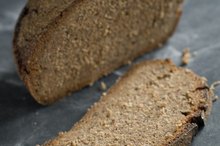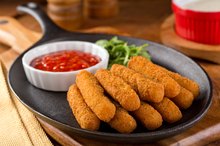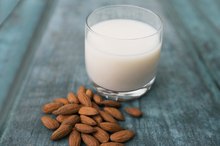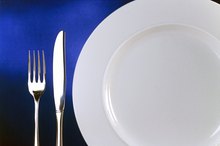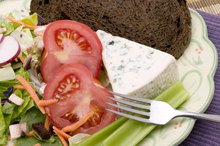Nutritional changes usually comprise the first steps in treating pancreatitis. The pancreas is a gland that’s located just behind your stomach and plays a major role in digestion. It works in concert with the gall bladder to produce digestive enzymes and control your insulin levels as well as the amount of blood sugar, or glucose, that’s released into your system. You should consult your doctor before making any changes to avoid complications. Most likely your diet needs adjustment that may include eliminating high-fat foods such as ramen noodles.
Fat
There are between 14 and 18 grams of fat in a typical package of the dry noodle mix. According to the American Gastroenterological Association, your body has a difficult time processing fat when you have an inflamed pancreas, the hallmark of pancreatitis 2. Additionally, a high-fat diet can raise your triglyceride levels, which can cause acute pancreatitis. You may first notice the condition after eating ramen noodles or other fatty foods. Initial symptoms include severe pain that starts high in your abdomen and radiates around to your back.
- There are between 14 and 18 grams of fat in a typical package of the dry noodle mix.
- According to the American Gastroenterological Association, your body has a difficult time processing fat when you have an inflamed pancreas, the hallmark of pancreatitis 2.
Carbs
Kekwick Diet
Learn More
If you have diabetes mellitus, or type 1 diabetes, your pancreas cannot process carbohydrates effectively because it doesn’t produce sufficient insulin. One package of the inexpensive noodle dish contains an average of 54 grams of carbohydrates. Ramen noodles eaten on their own may satisfy your needs for carbs without raising your blood sugar levels inordinately, making it a satisfactory choice as long as you don’t add any other carbs to the meal. According to the American Diabetes Association, you should aim to eat no more than 45 to 60 grams of carbohydrates at a single meal 3.
- If you have diabetes mellitus, or type 1 diabetes, your pancreas cannot process carbohydrates effectively because it doesn’t produce sufficient insulin.
- Ramen noodles eaten on their own may satisfy your needs for carbs without raising your blood sugar levels inordinately, making it a satisfactory choice as long as you don’t add any other carbs to the meal.
Additives
Refined foods such as ramen noodles that contain high amounts of sodium and monosodium glutamate, can exacerbate pancreatitis and increase symptoms, according to the University of Maryland Medical Center 1. For the best results, you should avoid all refined and processed wheat products that include pasta, sugar and white bread. Instead, opt for a diet high in antioxidants such as fresh fruit and vegetables that can attack the free radicals that often play a role in pancreatitis disease.
Dieting
Can Diabetics Eat Rye Bread & Pumpernickel Bread?
Learn More
Ramen noodles often play a role in quick weight loss programs because you can eat the entire package as a meal and only ingest about 380 calories. One of the side effects of losing weight too quickly is the development of gallstones. Gallstones produce the bile needed by the pancreas to function properly. When the bile ducts become blocked, you can develop pancreatitis. On the other hand, a diet consisting of more than one package of ramen noodles on a regular basis can have the opposite effect and sabotage your diet efforts. Talk to your doctor about how to incorporate the quick meals into a safe and balanced diet for losing an average of 1 to 2 pounds a week instead of trying fads that limit your food choices and lead to side effects and complications.
- Ramen noodles often play a role in quick weight loss programs because you can eat the entire package as a meal and only ingest about 380 calories.
- Talk to your doctor about how to incorporate the quick meals into a safe and balanced diet for losing an average of 1 to 2 pounds a week instead of trying fads that limit your food choices and lead to side effects and complications.
Related Articles
References
Writer Bio
Linda Ray is an award-winning journalist with more than 20 years reporting experience. She's covered business for newspapers and magazines, including the "Greenville News," "Success Magazine" and "American City Business Journals." Ray holds a journalism degree and teaches writing, career development and an FDIC course called "Money Smart."

